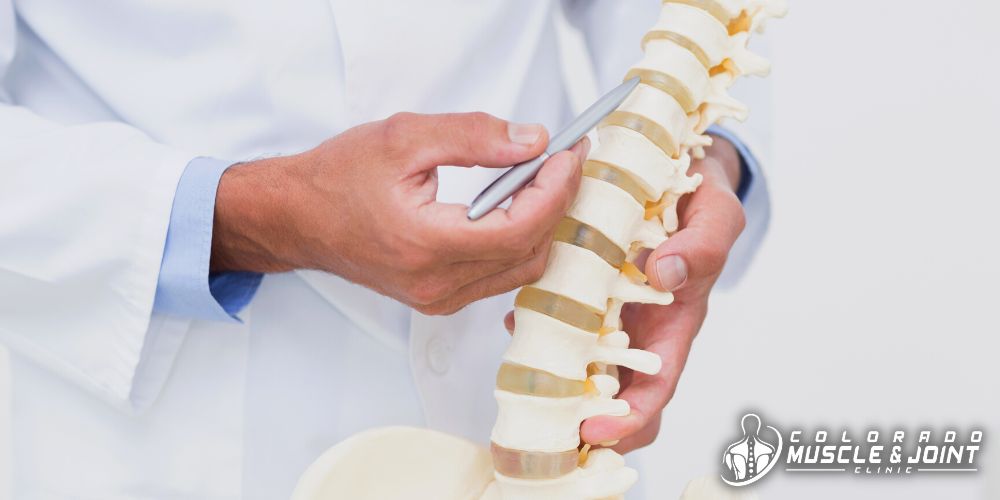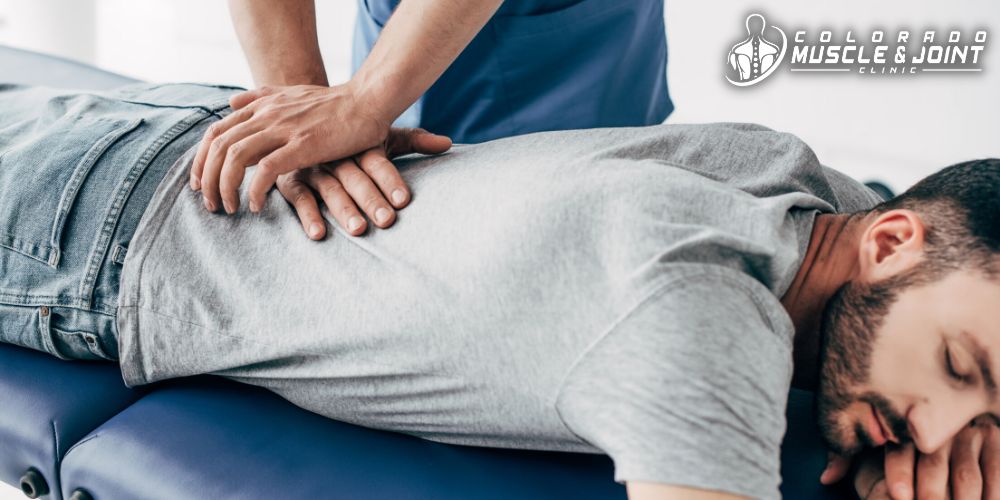Spinal Manipulation
Spinal Manipulation in Loveland, CO
Spinal manipulation has been a crucial part of complementary and integrative health care plans for centuries, with Hippocraties being one of the first to use this treatment in documented medical history.

Spinal adjustments come with a wide variety of health benefits, such as pain relief in the neck and back. Regular chiropractic care can also improve headaches, mobility, flexibility, and certain types of injuries. Basically, if you’re looking for a way to reduce pain throughout the body without the use of over-the-counter pain medications, chiropractic adjustments may be the best solution for you.
Dr. Huebner at the Colorado Muscle & Joint Clinic is a board-certified doctor of chiropractic medicine. He has years of experience in helping his patients live happier, pain-free lives. He can do the same for you. Call 970-744-6499 to schedule an appointment today.
What is Spinal Manipulation?
Spinal manipulation – AKA spinal manipulative therapy or manual therapy – is a form of alternative medicine that’s typically used within the chiropractic profession. During a spinal adjustment, chiropractors will use their hands to apply a quick thrust to mobilize the joints to improve range of motion and function.
Spinal adjustments can help reduce pain throughout the musculoskeletal system. In fact, many chiropractors use various types of manual therapies to relieve chronic low back pain, neck pain, limb pain, headaches, general inflammation, and more. Some health care providers claim that manual manipulation can even improve nervous system function.

History of Spinal Manipulation
The use of spinal manipulation for musculoskeletal pain relief dates back centuries. In fact, historians believe that chiropractic manipulation in Europe dates as far back to 400 BCE. However, other countries used spinal adjustment techniques around this time as well, including communities in Indonesia, Hawaii, India, China, Mexico, Japan, Russia, etc.
Hippocrates – often referred to as the “Father of Medicine” – was the first to document spinal manipulation using gravity as a treatment for scoliosis. His treatment plans included tying patients to ladders and hanging them upside down as well as using his hands or other devices to move prominent vertebrae back into place. He also instructed his patients to do specific physical therapy exercises after their treatments.
Manipulative and physiological therapeutics – such as spinal manipulation – were widely used to treat musculoskeletal problems up until around the 18th century. This is when manual therapy became a bit controversial between all the different types of doctors. Historians are not clear on exactly why so much contention about chiropractic care arose during this time, but some believe it was related to the dangers of manipulating the spines of tuberculosis patients. Tuberculosis was a widespread health issue at the time, and a byproduct of the illness was weakened bones and spines.
By the time the 19th century rolled around, a famous surgeon named James Paget stated that the medical success of “bonesetters” was mostly due to luck, and not skill. He also frequently referred to bonesetters as “enemies.”
At the start of the 20th century, health care providers began recognizing and studying the benefits of chiropractic adjustments, with medical literature at the time stating: “It is very remarkable that the medical profession for so long has neglected a wide field of therapeutics.” Also around this time, Daniel David Palmer formed the basis of modern chiropractic medicine. His theory was that many types of diseases were caused by misalignments in the spine (subluxations), and these misalignments prevent the nervous system from healing itself.
Since then, chiropractic care has widely been acknowledged as an effective treatment for both musculoskeletal and non-musculoskeletal disorders alongside traditional medical care.

Types of Spinal Adjustments
There are two main types of spinal adjustments used within the chiropractic field:
- Spinal Manipulation, in which chiropractors use their hands to apply a quick, controlled force on the spine or other joints. Patients will often hear cracking sounds in their neck or back, similar to the sounds you would hear if you cracked your knuckles.
- Spinal Mobilization, which involves less force on the spine and other joints. The chiropractor may use forms of soft tissue therapy like stretching or massage on the problem area. They may also use something called an “activator,” which is a spring-loaded mechanical instrument that can be used to realign the spinal joints with less force.
In both types of chiropractic adjustments, patients can expect to lay down on a chiropractic table. The chiropractor may ask you to twist or move certain parts of the body in order to realign the spine. They may also stretch or massage surrounding muscles, depending on your musculoskeletal health history and other symptoms.
Is Spinal Manipulation Safe?
Yes, spinal manipulation is safe as long as it’s performed by an experienced and licensed chiropractor. Serious complications from chiropractic adjustments are rare, but can definitely occur if you see an unlicensed provider.

Chiropractors must have a Doctor of Chiropractic (D.C.) degree in order to safely perform spinal manipulative therapy. Good news – Dr. Huebner at the Colorado Muscle & Joint Clinic is both experienced and properly licensed for administering chiropractic care. You can trust that he will safely improve your musculoskeletal pain starting at your first visit.
Is Spinal Manipulation Effective?
More clinical trials need to be conducted in order to properly document the benefits of manual therapies like spinal manipulation.
However, a 2007 study states that spinal manipulation was moderately effective in reducing chronic low back pain lasting more than 4 weeks.
Another study states that nearly 70% of participants who suffered from neck pain experienced relief from 6 weeks of chiropractic adjustments.
Lastly, the American Chiropractic Association states that patients with low back pain who received regular chiropractic care had 90% decreased odds of using opioids for short term or long term pain relief.
In general, a chiropractic adjustment may be effective in treating the following issues:
- Chronic and acute low back pain
- Neck pain
- Headaches
- Arm and leg pain
- Improving range of motion of the head, neck, and back
- Improving mobility and flexibility throughout the body
- Accelerating the healing of certain types of injuries
What Are the Popping Sounds That Occur During Spinal Manipulations?
You may be intimidated by a chiropractic adjustment solely due to how loud the popping sounds can be. How do you know a chiropractor isn’t accidentally breaking something with popping sounds that loud?
The loud popping sound during a chiropractic adjustment is nothing to be afraid of. It’s basically just the release of gasses (such as carbon dioxide, nitrogen, and oxygen) from a spinal joint. But how does gas get trapped inside joints to begin with? Basically, it happens when you move or stretch your body. The sounds you hear during a chiropractic adjustment are no more dangerous than the sounds you hear while popping your knuckles.
Is Spinal Manipulation Painful?
Most patients say that they don’t experience any pain when a chiropractor applies controlled force during a spinal adjustment. At most, you may feel mild discomfort from popping and stretching. Experiencing severe pain during a chiropractic adjustment is very uncommon.What to Do After a Spinal Manipulation
Most chiropractors will send you home with “homework,” or basic stretches and other therapies that can further aid in pain relief. For example, Dr. Huebner may recommend:- Ice or heat therapy on the problem area.
- Instructions about maintaining proper posture while sitting or standing.
- Basic exercises and stretches to improve function and pain in the problem area.
- Advice about nutrition and dietary supplements to improve general health.
- Stress relief and muscle relaxation techniques.


